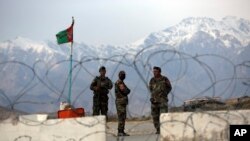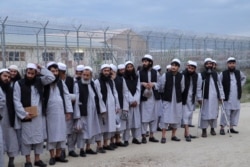Officials in Afghanistan alleged Saturday the Taliban has “killed or wounded” nearly 800 civilians since signing the February 29 peace-building deal with the United States. A spokesman for the Islamist insurgency swiftly rejected the charges.
The allegations came on a day when Washington's peace envoy for the war-torn country, Zalmay Khalilzad, again called on the warring sides to work for peace, saying the U.S.-Taliban agreement “provides a historic opportunity for Afghanistan.”
A national security council spokesman in Kabul, while releasing details of the stepped-up insurgent violence, claimed the Taliban conducted more than 2,800 “terrorist activities” between Feb. 29 and April 20, killing and wounding "789 civilians during this period.”
Javid Faisal went on to say Afghan security forces in counter attacks also inflicted more than 2,700 casualties on the Taliban. “Last week was the bloodiest since the U.S.-Taliban deal, with the Taliban killing 34 and wounding 62 civilians across 17 provinces,” he said without elaborating.
Taliban spokesman Suhail Shaheen, when contacted by VOA for his reaction, questioned the veracity of the government claim on civilian casualties.
“This is a general claim, can they say where and when?” Shaheen asked.
Battlefield clashes have escalated in Afghanistan as the annual spring fighting season arrives, killing scores of combatants on both sides in the past week alone. Afghan media reported government forces suffered up to 100 deaths.
US seeks quick prisoner swap
The violence prompted U.S. and NATO allies to urge Afghan leaders to focus on the next steps outlined in the agreement to promote peace and stability in the country.
“How urgently and with what conviction the sides respond to these steps will determine whether Afghanistan moves forward or remains mired in war, poverty, and disease,” said Khalilzad.
Khalilzad was referring to an extremely slow-moving prisoner swap between Kabul and the Taliban, a crucial confidence-building step before parties to the war can come to the negotiating table to discuss peace and a power-sharing arrangement.
Under the U.S.-Taliban agreement, up to 5,000 insurgent prisoners were to be freed from Afghan jails in return for 1,000 government forces being held by the Taliban. But Kabul has so far released around 550 prisoners in phases and the Taliban has freed 60 detainees.
Khalilzad, in his statement Saturday, stressed the need for all sides to “move more quickly on prisoner releases” and urged the Taliban to reduce violence.
The Afghan government is demanding the Taliban declare a cease-fire and engage in a productive peace dialogue before all prisoners are freed.
The insurgents, however, have rejected calls for a cease-fire, insisting only a “full implementation” of its agreement with Washington would move the peace process forward.
“This is our stance that the prisoners should be released prior to commencement of intra-Afghan negotiations,” Taliban spokesman Shaheen told VOA.
He reiterated that his group is determined to deliver on its own commitments outlined in the pact with the United States.
The agreement requires all U.S. and coalition forces to withdraw from Afghanistan by July 2021 in return for insurgent assurances not to allow the country to be used for terrorist attacks against other countries.
“We want good relations with our neighboring countries as well as of the region. As per the agreement, we will not allow anyone to use our soil against any other country. For that, we will make legislation in the future,” Shaheen told VOA.
Political crisis
Kickstarting intra-Afghan negotiations, however, is not the only challenge facing the landmark U.S.-Taliban accord. A lingering dispute stemming from the September presidential election in Afghanistan continues to hamper efforts to bring the warring parties to the negotiating table.
Incumbent President Ashraf Ghani and runner-up Abdullah Abdullah both claim to have won the election. The rival Afghan leaders held competing inauguration ceremonies last month, fueling political tensions at a time when Kabul was supposed to present an inclusive negotiating team for the proposed intra-Afghan dialogue with the Taliban.
Khalilzad backed NATO’s call this week for the Ghani government to end the political crisis, urging Afghan leaders on Saturday “to put their country and their people first.”






